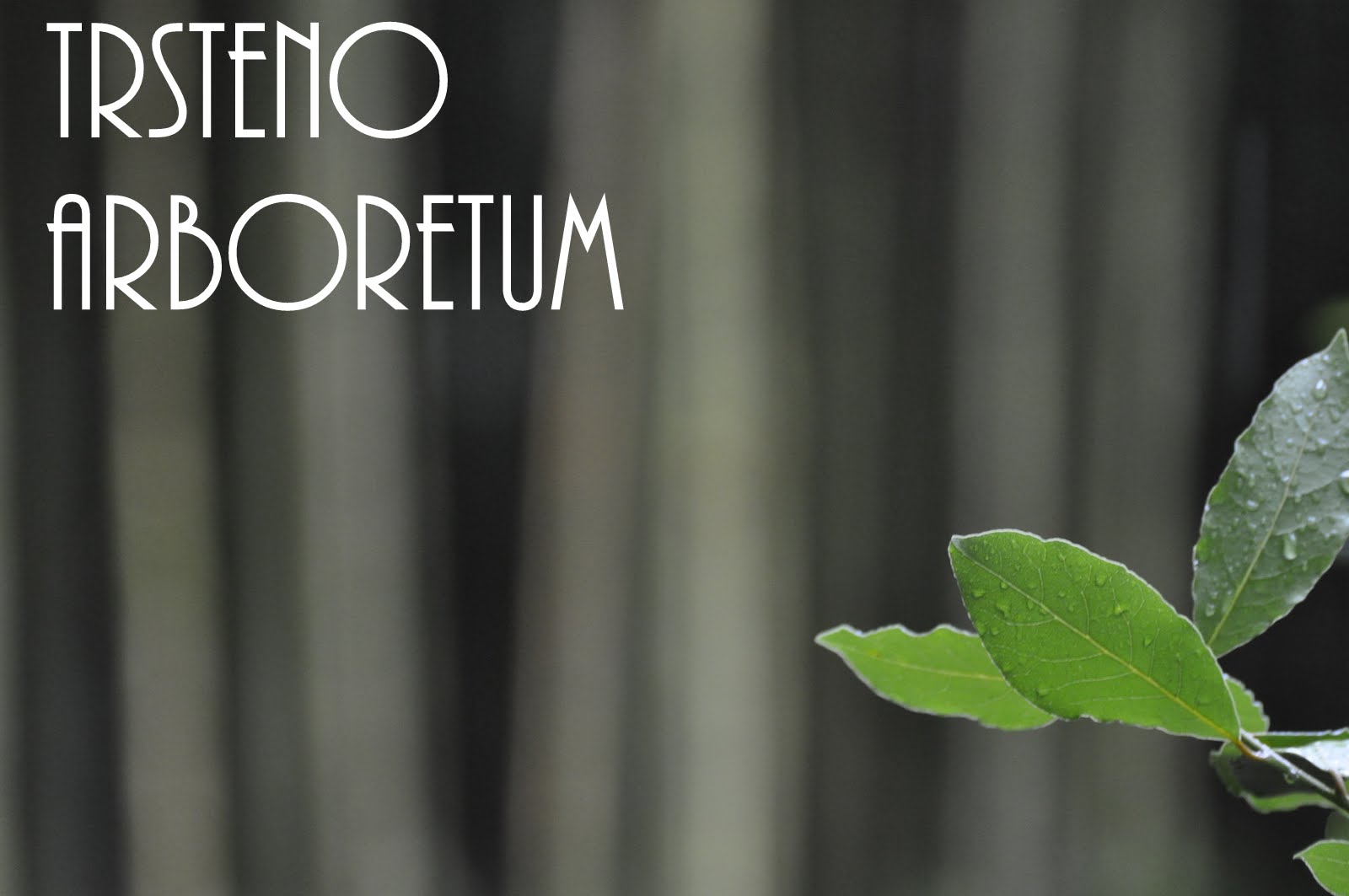
Note: This presentation provides further pictures and commentary for our Dubrovnik overview. It's best to see that presentation first by clicking here.
| You may prefer to see these pages as a photo slide show which contains the same text but presents the pictures full screen size. If so, click on the slides presentation at the right. |
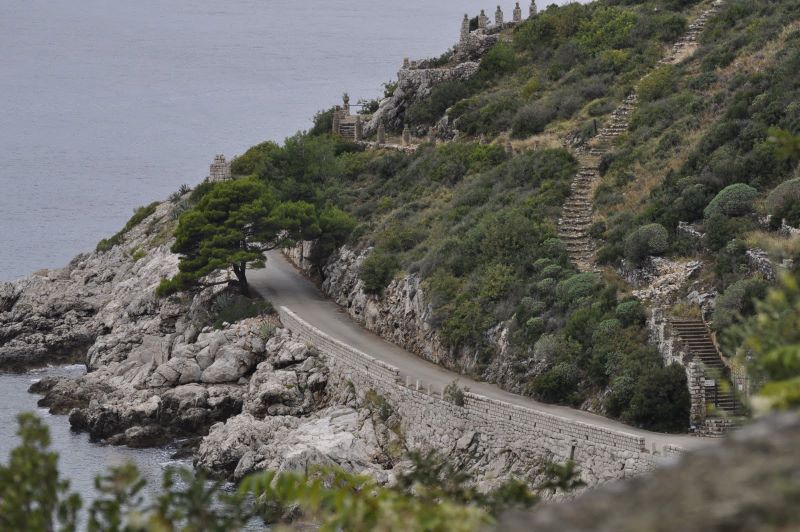
Here's a typical view of the Dalmatian coast a few miles north of
Dubrovnik: lots of rocky coves reaching up to mountains steeply
descending to the clear sea.As you can see, it's not an ideal place for
Italian Renaissance gardens whose symmetrical boxwood hedge layouts eat
up a lots of flat terrain...
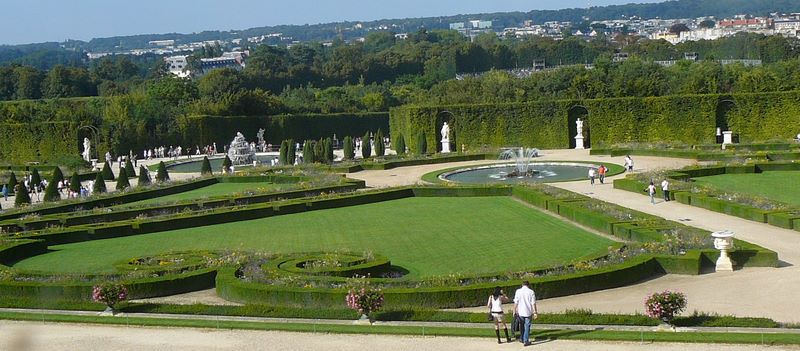
...like this taken at Versailles. (OK, this place is French, but its
lineage to the Renaissance gardens of Tuscany is pretty direct thanks
to the Medici's providing queens for the kings of France.) The gardens
around Dubrovnik have Renaissance pretensions, but not much room for
such double axes layouts defined by boxwood. Instead, they use stones
-- lots of them -- and adapt to the steeply descending mountain terrain
usually with terraces. Instead of these double axes which cross at a
grand fountain, they are lucky to get one axis (path) stepping down
terraces. But the steep descent that makes the above view impossible
makes another quite likely: sloping gardens with great views of the
blue Adriatic.
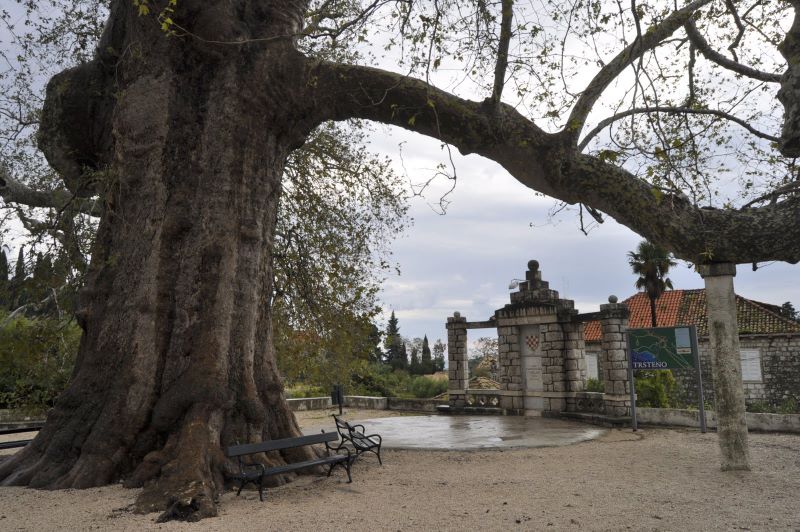
The best preserved of these garden-villas is at Trsteno, a village up
the coast about 12 miles from Dubrovnik and once a popular place for
homes for seamen and rich citizens of Dubrovnik. Today, tourists come
for the Arboretum, a few hundred yards from this spot. However, the
Arboretum appears to take jurisdiction over two huge Oriental plane
tees right on the highway in the village square. Their locations is no
surprise. Such large old plane trees are common in town squares in this
region as they thrive on hot summers if they can get sufficient water
and town squares were often located over springs.

The two Oriental plane trees in Trsteno's square are nearly 200 feet
tall and about 16 feet in diameter and are thought to be 500 years old.
If so, they would have been planted about the time a prominent
Dubrovnik family established their villa which became today's arboretum
-- just down a winding verdant slope a few steps from here.
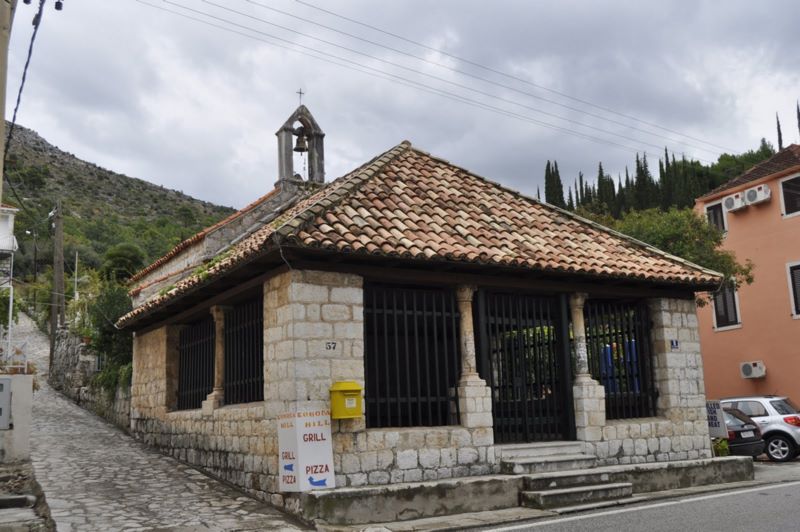
Across from the square is a small and simple chapel (or perhaps the
parish church as only about 250 people live here). It features this
large vestibule. Excavations of Trsteno's Catholic church suggest
humans settled here at least by the 5th century. Does your church have
a yellow mailbox?
Because this area was 1) close to Dubrovnik and 2) under that town's permanent control, it was a favored spot for the nobles to place their summer homes. About 300 estates have been found in this area and about 70 Renaissance villas are somewhat preserved with about 20 in reasonable shape. Most were built during the 16th century after the 1520 earthquake. The 20th century saw the demise of most of Dubrovnik's estates as urban growth devoured land near cities. Many that survived were attacked during the 1991 war. If anything is left, it's typically the house itself, not the gardens. Trsteno's garden/arboretum is alone in being protected as a complete complex. (But with no thanks to the attacking Serbs.)
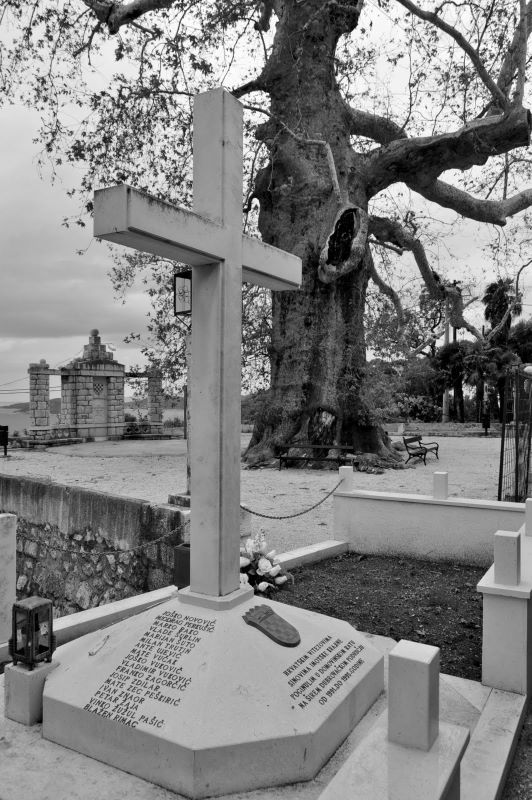
Even though the village has a population of just over 200 people, it
keeps its sparse war memorial spotless. The village square, shaded by
the massive Oriental plane trees stands quietly beside.The Serbs
(Yugoslav People's Army) attacked the Arboretum by sea and air,
destroying a large part of it as a form of cultural eradication since,
as far as we can tell, the exotic fauna were up to no subversive
activity.
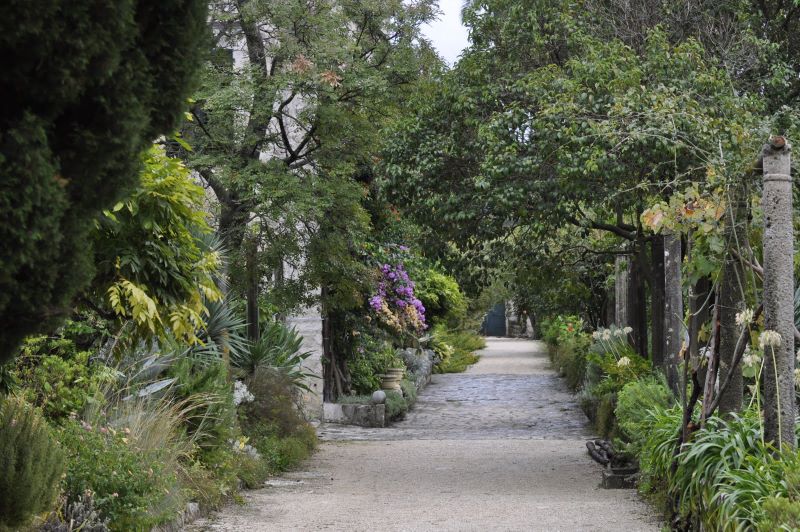
A prominent Dubrovnik family established their summer residence here
around the time that Columbus was sailing on his first voyage. (As
trade with the New World increased, the Maritime Republics such a
Dubrovnik and Venice would begin their long economic decline as they
were no longer at the center of the trade routes.) This estate started
with a Gothic-Renaissance home erected by Ivan Marinov Gucetic-Gozze.
As you can see, today this is more of an arboretum than an Italian manicured garden. Dubrovnik's landscape architects would typically provide a single path (axis) about 100 yards long and about 10 feet wide. Instead of Italian boxwood hedges, they would use stones to create walls of various heights. At the edges would be the tallest walls to make the garden look inward -- except on the sea side, where, of course, they would highlight the sea view often with a belvedere.

Dubrovnik gardens tried to please the nose as much as the eyes with
aromatic citrus plants and herbs being favorites (and useful in
cuisine, as well.)After WWII, this estate was confiscated by the
communist regime. Eventually it was placed under the control of the
Yugoslav (and later Croatian) Academy of the Sciences and received
modern scientific management.The communists were not the first to
discourage the wealthy from holding elaborate estates. At its peak,
Dubrovnik banned excessive luxury and the flaunting of wealth through
extensive gardens.

While Dubrovnik seamen were encouraged to bring back seeds from all
sorts of exotic species, they primarily stuck to those of
flowers.Dubrovnik's landscape architects are, for the most part,
unknown. It's likely that designs were sent from Italy as many Italian
architects and craftsmen (especially from Florence) lived in Dubrovnik
while on commission. However, Italian landscape architects would not be
effective unless they were on site as the Dalmatian coast presents
significant challenges to Tuscan garden designs which assumed
relatively flat spaces suitable for boxwood hedges forming
criss-crossing axes. But while Dubrovnik's gardens are smaller and more
modest than their Italian counterparts, they exploit their high vistas
of the sea.

Given the mild climate, Dubrovnik's gardens (like those in Italy) were
extended salons and used for plays, readings, and other family
entertainment. The prominent Dalmatian philosopher Nikola Vitov Gucetic
wrote much of his work here in his family's garden.

What makes this garden work even today is the aqueduct with its 14 arches leading to a Renaissance fountain.

The aqueduct leads over 200 feet to a fountain below. Few Dubrovnik
gardens had such aqueducts and the use of the town's water for gardens
was prohibited after 1436. Most irrigated by gathering rainwater in
reservoirs.

At the center of the fountain are statues, including that of Neptune,
god of the sea which he can just about see from his vantage point.
Originally, the aqueduct ended in a cave with statues. This redo with
Neptune, 2 nymphs, and a dolphin is from the 18th century. Statues in
Dubrovnik gardens were integrated with their fountains and never stood
alone.

Dubrovnik fountains usually spewed their water through masks placed on
niches of the garden wall, unlike this full statue here at this upscale
villa. The main reason for this was that the garden walls would be
capped by channels designed to move the flow of rainwater to or from
reservoirs.Because of the challenges of the terrain and lack of water,
Renaissance gardens in Dubrovnik were small with an average size of
just over an acre. Typically these would have only a single-axis as is
the case for Trsteno which was once of the earliest Renaissance gardens
in Dalmatia (and even earlier than most in Italy). However, Trsteno's
garden is much larger at about 4.5 acres.

The steep slopes of the Dalmatian mountains as they reach the Adriatic
usually makes the broad symmetry of the Italian garden impossible.
Instead, these same slopes would provide great sea views and encourage
the landscape architects to provide belvederes.

Most of the fishponds in Dubrovnik gardens are connected by channels to
the Adriatic and have salt water as fresh water is often in short
supply here. At Trsteno, the aqueduct brings down fresh water.Such
fishponds were not only aesthetic but served as fish hatcheries and as
microclimates to help cool the hot Dalmatian summer.

Italian gardens often exhibited elaborate topiary -- all but unknown to
the gardens of Dubrovnik. But the biggest difference is water --
Italian gardens have lots of fresh water usually rushing through
fountains. Dubrovnik gardens border the sea and have ponds of salt
water. Rainwater is too precious and in too little supply to power
fountains. Nearly unique to Dubrovnik, Trsteno's garden has both.

A bit of earthquake resistance incorporated into the villa walls.

Unlike the Renaissance gardens of Italy, Dubrovnik gardens often
contain pergolas for vines, often leading to (and extending) the house.
Typically their supporting columns would be placed on low walls which
define the garden in the absence of boxwood shrubs. This use of stone
walls evolved from the monastery gardens of the middle ages. Pergolas
themselves are much older and date back to at least ancient Egypt.

Here we look through the belvedere pavilion to the Adriatic and the
Elafiti Islands where other prominent Dubrovnik families would have
their villas.

The sea here is bordered by this stone dock often referred to as the
arsenal. Most Dubrovnik gardens use descending terraces to tame the
slopes -- again an idea borrowed from medieval monastery gardens.

Our ship captain claimed this was Tito' s second home; today it rents for 7,000 Euros per night.

...and the belvedere -- as if you'd have any difficulty seeing the Adriatic from this location.

Caves are probably common given the limestone/karst shore

The rest of these slides are pictures of some of the fauna -- with very
little captions. You probably want to click through fast or use as a
screen saver. See them full screen by clicking here.

OK, it's not fauna but I thought it was interesting like a William
Carlos Williams image. So much dependsupon a blue fire hydrant glazed
with rainwaterbeside the white chickens.

Thanks for staying with us. See the main Dubrovnik pages at by clicking here.
Thanks to Mladen Obad Scitaroci for some of the information found on these slides.
|
Please join us in the following slide show to give Dubrovnik's Trsteno Arboretum the viewing it deserves by clicking here. |
Geek and Legal StuffPlease allow JavaScript to enable word definitions. This page has been tested in Internet Explorer 8.0, Firefox 3.0, and Google Chrome 1.0. Created on January 10, 2010 |
 |